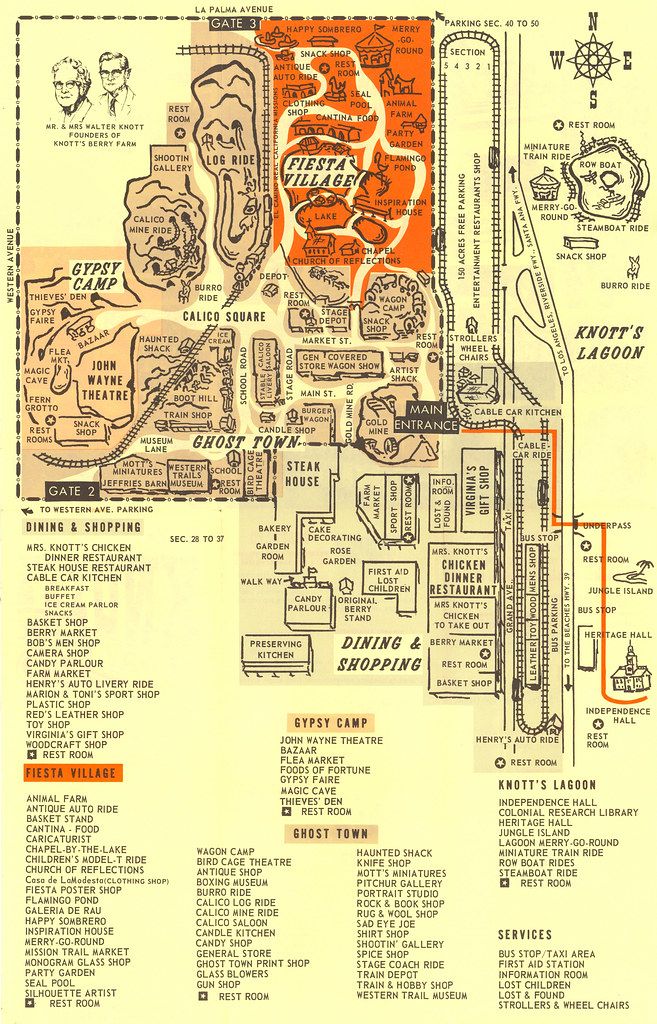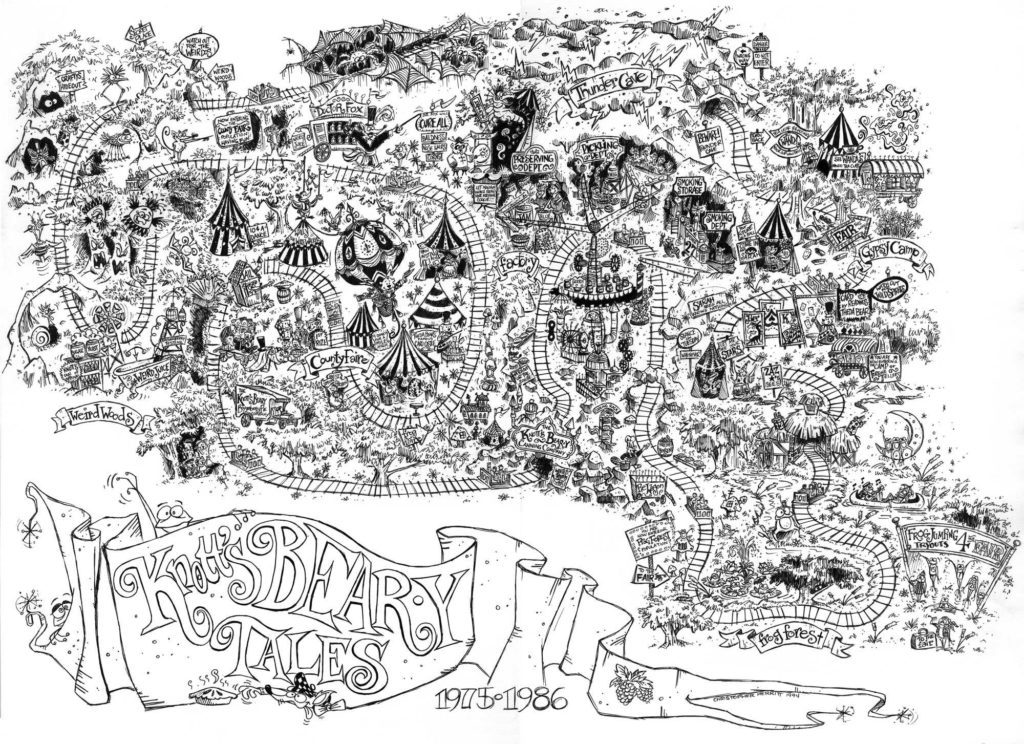Fortunes and Fires and Bears
Given that attractions outside of Disney’s realm aren’t usually as well documented in their design and construction, many of the best stories about the making of Knott’s Bear-y Tales could easily have been lost to time… if Crump himself hadn’t told them! In both More Cute Stories Vol. 6 and a storytelling interview chronicled in Chris Merritt’s 2010 book Knott’s Preserved, Rolly recalled the unusual circumstances that lead to the ride’s design.
We know that in 1971, Marion Knott decided the time was right to expand the park with the addition of a third themed area. Joining the original Ghost Town and 1969’s Fiesta Village was the new Gypsy Camp. (Note: Today, “Gypsy” is considered a pejorative and offensive term to describe the traditionally-nomadic Romani people. Likewise, the notion of being “gypped” (swindled or cheated) connotes Romani people with illegality and thievery, further exemplifying the term’s racist origins. The name ‘Gypsy Camp’ is used here in the context of the park’s historic themed area only.)
A multi-level land built into sculpted cliffs, the nomadic camp invited guests to into flea markets, bazaars, vardo wagons, and mystical fern grottos where traveling performers, organ grinders, fortune tellers, and musicians brought the land to life. Given the success of the Calico Mine Ride and Log Ride, however, Marion reportedly felt that Gypsy Camp needed a dark ride of its own.

Though disguised behind a rocky facade, the land’s largest building offered two arcades (the Gypsy Faire on level two and Thieves Market on level one), either of which offered 20,000 square feet of potential showspace. Crump was personally recommended.
Rolly told Chris Merritt, “I had grown up with Knott’s since I was 9 years old! I remember when it really was a farm! I even remember before the Ghost Town, when my grandfather would take us down there for the chicken dinner and boysenberry pie.” By September 1974, Crump was on the project.
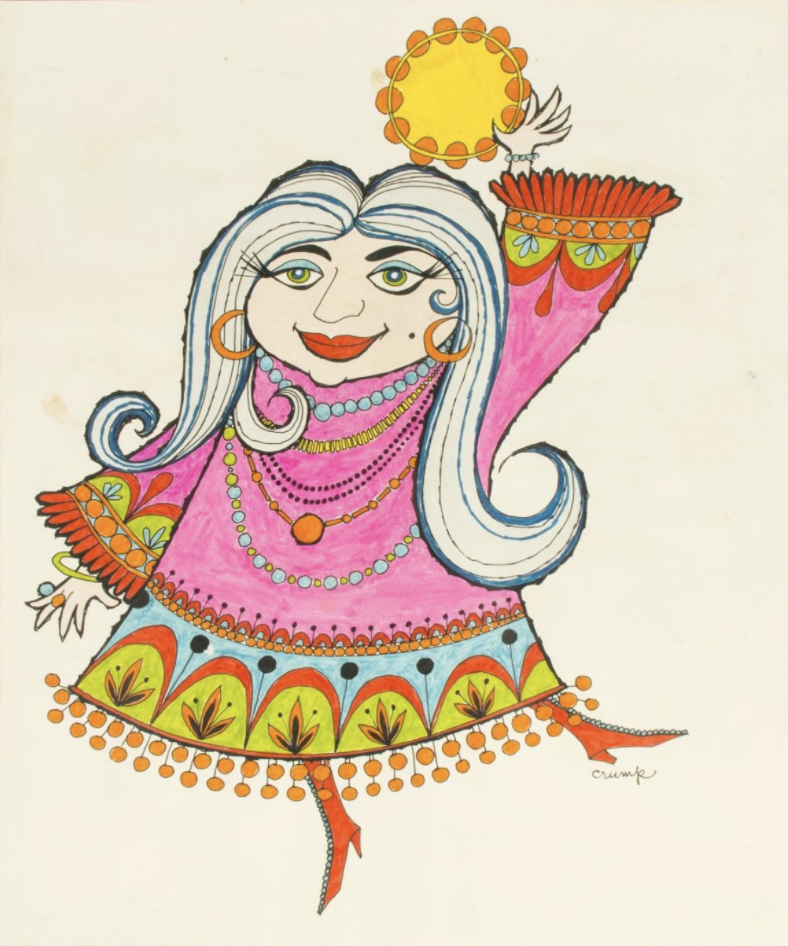
Working with an idea proposed by young Knott’s designer Wally Huntoon (a story of a young boy and his donkey heading to a fair), Crump concepted a dark ride passing through a frog forest and into nomadic Romani camp filled with dancers, artists, mystics, and fortune tellers. Crump recalled that of all his sketches, a favorite among the Knott family was one showing a fortune teller dancing with a family of bears. That’s what lead the family to consult with an outside marketing firm. “I said, ‘You know, Walt Disney never test marketed anything. If he felt it was a good idea, he just went ahead and did it,'” Crump recalled.
Ultimately, though, Crump concedes it was “probably a good idea” given that when the results came back, the crew was tasked with transforming all the human characters into animals and the “Knottsenbear-y” family was born.
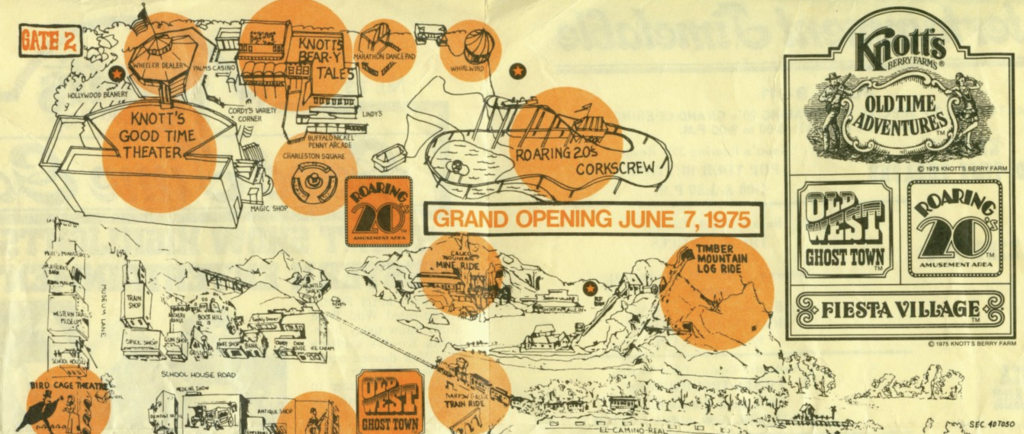
As luck would have it, new concepts added to the ride – like the bear family and the idea of an opening scene passing through a boysenberry jam factory – were good complements to a much larger transformation taking place. Coinciding with the arrival of the world’s first modern inverting roller coaster (Arrow Development’s Corkscrew), Marion decreed that the entire Gypsy Camp area that had only debuted four years earlier ought to be redesigned as an ode to the heyday of her parents’ generation: the Roaring 20’s.
The artificial cliffs were removed and the buildings beneath re-clad as a glitzy, glamorous street of the 1920s. As for the dark ride, new duds and wigs were enough to transform the animals Crump had designed – and by extension the whole ride’s setting. “[T]he reason that it worked, was that we stayed with fantasy,” Crump recalled to Merritt; because “it was like looking at a children’s book,” the ride was adaptable to the changing environment of the park.
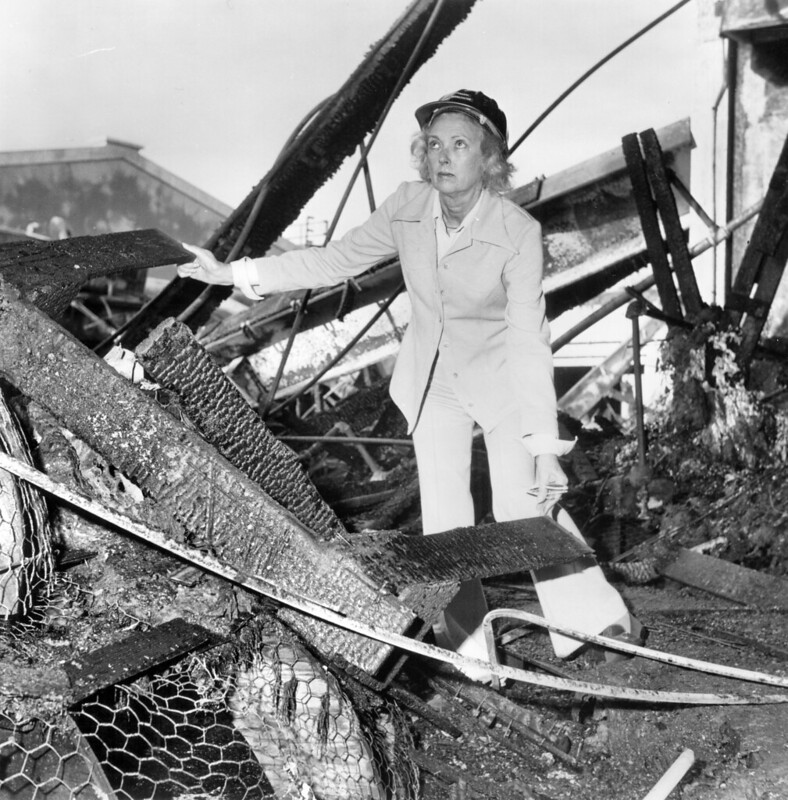
With about half the ride installed in the second-story space in April 1975, an overnight fire destroyed nearly everything that had been constructed. (It’s believed that the ride’s destruction was an act of arson related to a union dispute. Marion Knott can be seen surveying the damage in the Orange County Archives image to the right.) Despite the massive setback, it was “full speed ahead” for Knott’s Bear-y Tales. With just six weeks until the ride’s planned opening, set pieces were rebuilt and final touches installed. Crump recalled to Merritt, “It took Chris [Crump, his son and Disney Imagineer,] 3 months to build the Chug the first time—because he did it from scratch—and the next one he did in 6 weeks!”
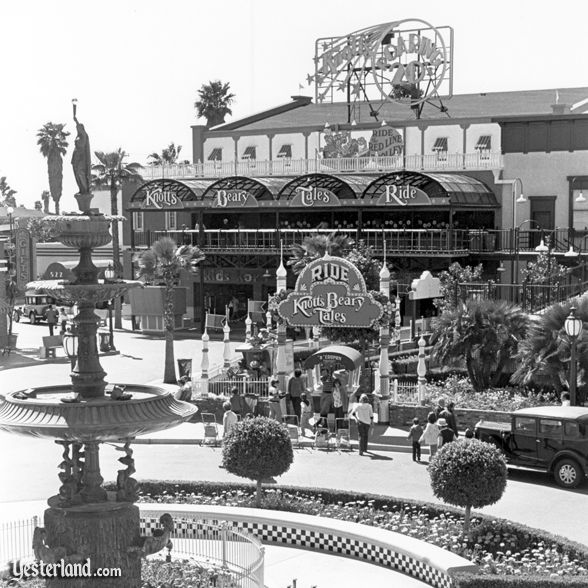
Amazingly, the ride was delayed less than a month, ultimately opening just after the rest of the Roaring 20’s area on July 4, 1975. The old, two-story arcade of the Gypsy Camp didn’t clean up too badly, with Knott’s Bear-y Tales taking up residence in the re-clad building resembling a streetcar substation and red car trolley garage.
Just beneath the glowing neon marquee of the Roaring 20s area, guests queuing for a trip into a Bear-y Tale could look out across Charleston Circle (including the plaza’s central fountain – a screen-used prop from 1969’s Hello, Dolly!). But under the arching glass canopies of the trolley garage, the real adventure would begin where all were welcome…
Knott’s Bear-y Tales
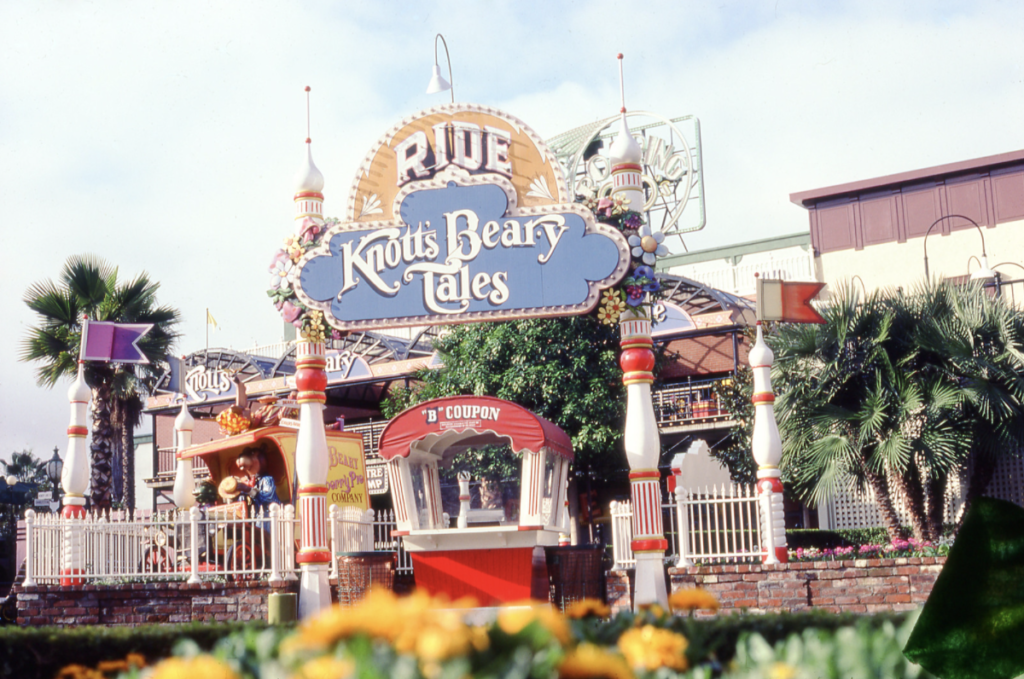
“Welcome one and welcome all, folks to a family fair for all,
Folks riding on Knott’s Bear-y Tale ride!
We’ll go back to the Roaring ’20s, and you’ll come back a’roarin’ plenty
When you see what the bruins are brewin’ inside!
Welcome one and all! Y’all come have a ball!
Things are very fine riding on the ole’ Knott’s Bear-y line!”

In that canon of infectious theme park melodies, Bear-y Tale’s “Welcome One and All” rivals even the Sherman Brothers’ Disney Parks tunes! Composed by Robert F. Brunner and Bruce Belland (unsurprisingly, Disney alums), the joyful hoedown follows riders through their Bear-y Tale from entrance to exit. For supporting our in-depth theme park history project, Silver, Gold, and Platinum Members of Park Lore can stream the ditty above – but be warned… it’s an ear-worm!
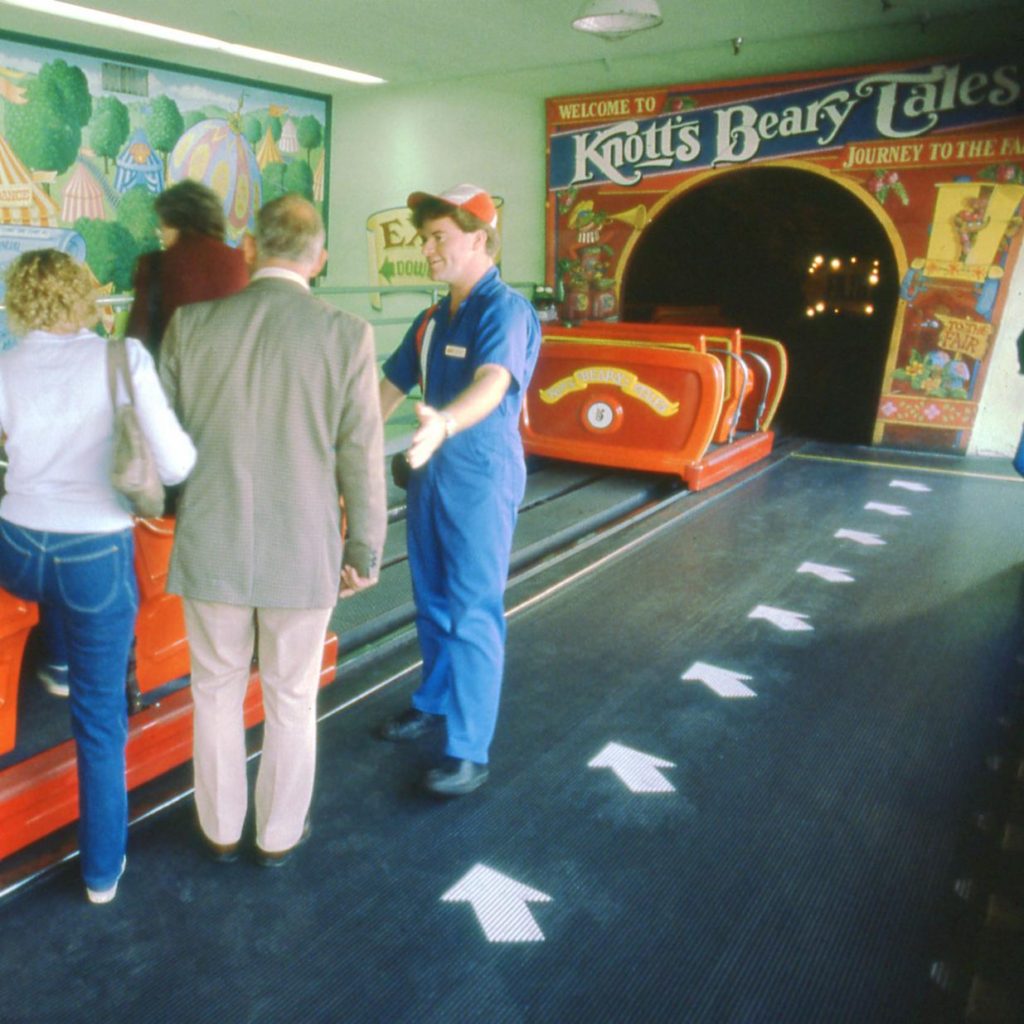
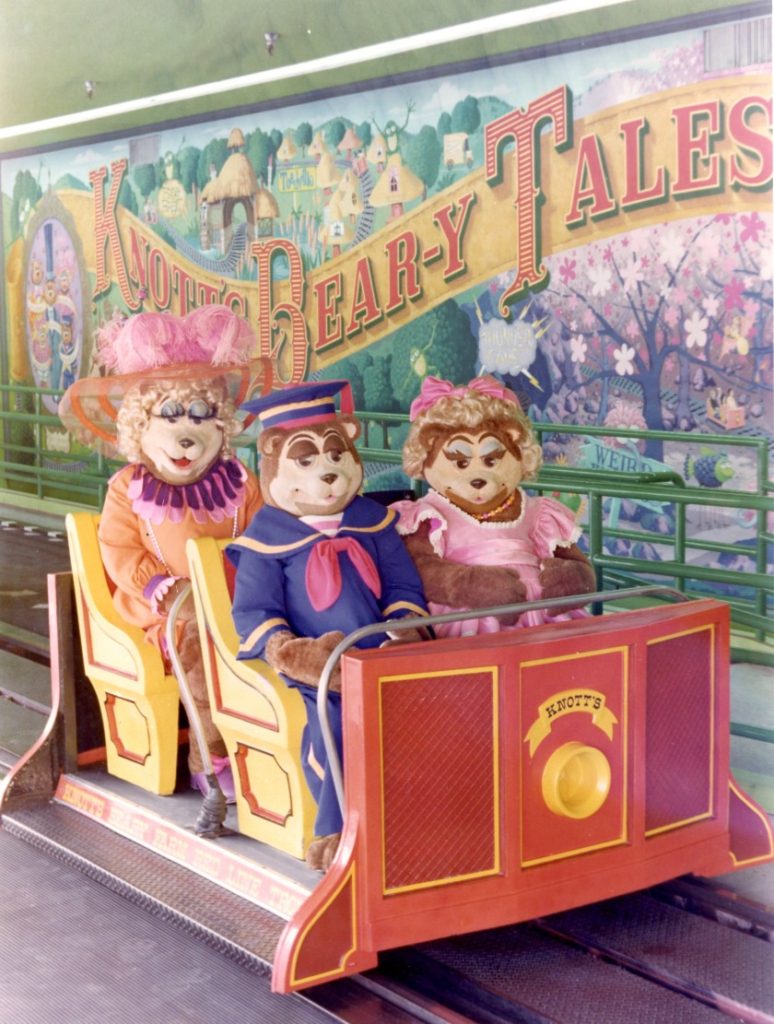
Ding ding! As guests reach the loading platform for Knott’s Bear-y Tales, they stand before a time-honored tradition dating to Disneyland’s classic Fantasyland dark rides: a beautiful mural stretching the length of the station. Painted by Suzie McLean, repeat riders may notice that the mural tells the story of guests’ coming journey to the County Fair, from the Boysenberry Bakery to the Frog Forest; Gypsy Camp to the Weird Woods. Of course, for this journey, neither mine carts nor jalopies will do. Instead, we’ll hop aboard a 1920s Red Car Trolley as it smoothly advances through the station – a continuously loading line of streetcars ready to whisk us into a storybook past.
“First you’ll see our bears ‘a’workin’, sort of berry soda jerkin’
Cooking up concoctions in a cave
Givin’ every jar the test, to find the very Bear-y best
The way they test there’s no jam left to save!
As the melodic fiddle tune of the ride’s theme turns to whistling and humming, our streetcar passes through a poster for the County Fair and begins a surprising uphill climb! Up over a hill, we’ve found ourselves in a cave shining with metallic copper machinery. The cavern factory of the Bear-y fam’ly business is bought to life with musical clanking and creaking, tooting steam whistles, whirring gears, and spinning Crumpian pendulums with beads clattering on spindles.
Now the reason folks are workin’ hard, in the house and in the yard
Is ’cause they’re all a’headin’ for the fair
Once y’all get over there, it won’t be hard to grin and bear it,
You’ll see have the fun is gettin’ there!”
It’s a joyful playground of sights and sounds, where chickens lay fresh eggs that tumble down ramps; Boysen and Girlsen Bear-y ride spinning gears in their factory playground; all manner of Bear-y cousins grind freshly harvested boysenberries into fresh jam, roll out dough, place finished pies onto an oven-bound conveyer belt, and load up a wagon filled with potentially-prize-winning delights bound for the County Fair. (Just look out for Crafty Coyote, who’s come to snatch a pie right off the cooling rack.)
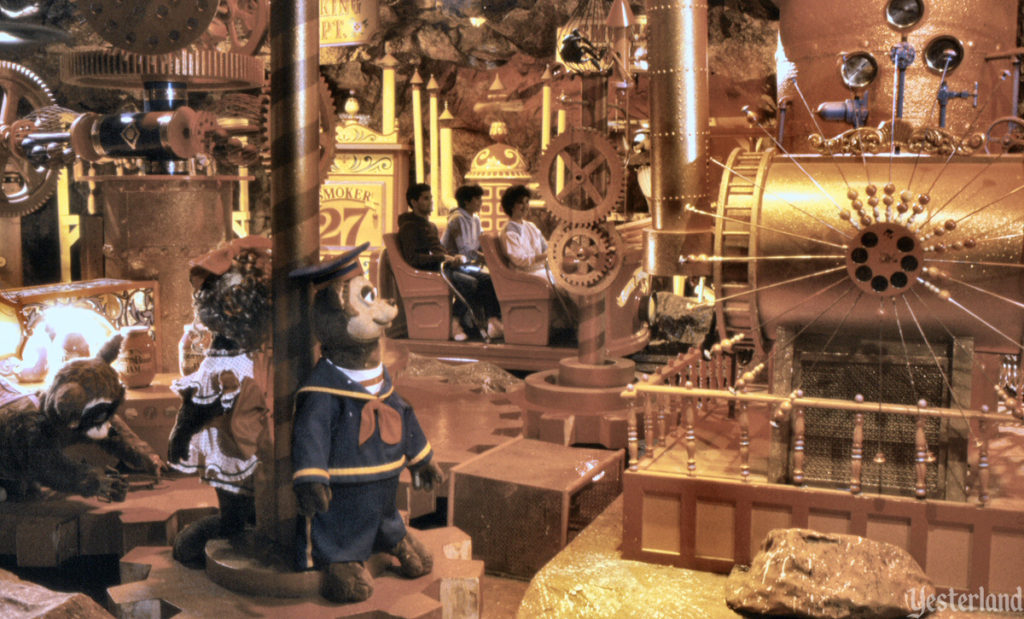
Most interestingly, though, the Boysenberry Bakery differs greatly from traditional dark ride lore in that it’s lit entirely with warm, incandescent lighting! Crump told Chris Merritt, “My idea was that you want to get your eyes accustomed to the light. A lot of the time in a line for a dark ride if you stand out in the sun too long, your eyes don’t have a chance to open up. When you get in the ride, you don’t see anything for the next 30 seconds! Well, some dark rides are only 90 seconds long! What I decided was to do incandescent in the Factory.”
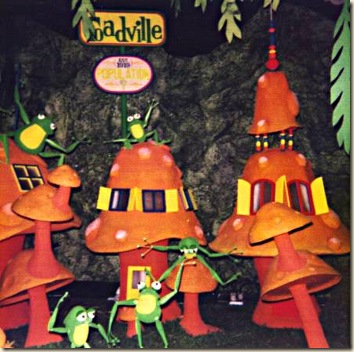
But with the pies loaded and ready for the fair, it’s time to begin the journey. Our first stop? Frog Forest. The trolleys exit from the cave and into the delightfully musical forest where weeping tree branches and giant mushrooms surround riders. Crickets chirp all around as playful frogs ribbit among the cattails, going about their chores. Better yet, frogs practice their contribution to the fair – a long jump competition – in a puppeted vignette. A final scene within the Frog Forest sees a gargantuan lady frog don her straw hat, ready to join the journey to the fair. (This scene, per Crump, introduces UV paint and blacklight, but keeps incandescent lighting on “water,” which, he says, “doesn’t sparkle very well under UV lighting.”)
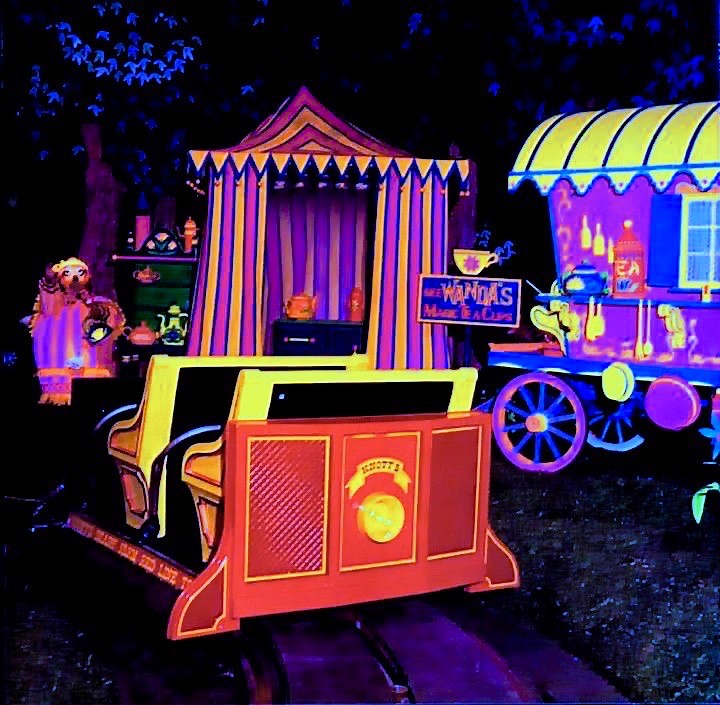
The trolleys lumber across an old covered bridge, leaving the chirping and humming of the Frog Forest behind. Instead, the sounds of tambourines and cimbalom dulcimers signal the arrival in a nomadic Gypsy Camp. Now deep in the forest en route to the Fair, all incandescent light has faded, replaced entirely with the glowing, otherworldly blacklight traditionally found in many Disney dark rides.
There’s a whole lot of mystical magic in there, with Sarah Skunk and Theda Bear
Wanda Fox, and an Owl who gives a hoot!
Things are floatin’ through the air! Ya see, their purpose is to scare
And tickle your fancy and your funny bone, to boot!
And there’s not a better place to put it to use than the Gypsy Camp, filled with ultraviolet vardo wagons, striped tents, fluttering flags, fine glowing porcelain, and comical signs for various fortune tellers. Even the trees are now aglow in moonlit hues, creating in the Gypsy Camp an otherworldly sense of place. Card readings with ThedaBear, floating instruments and seances with Zazz Owl, meeting with the mystic Sarah who “Sees All, Knows Nothing,” and Palm Reading by Wanda… Here in the Gypsy Camp, Knott’s Bear-y Tales reveals itself as the work of a master Imagineer, with memorable characters, perfect staging, and exceptional beauty.
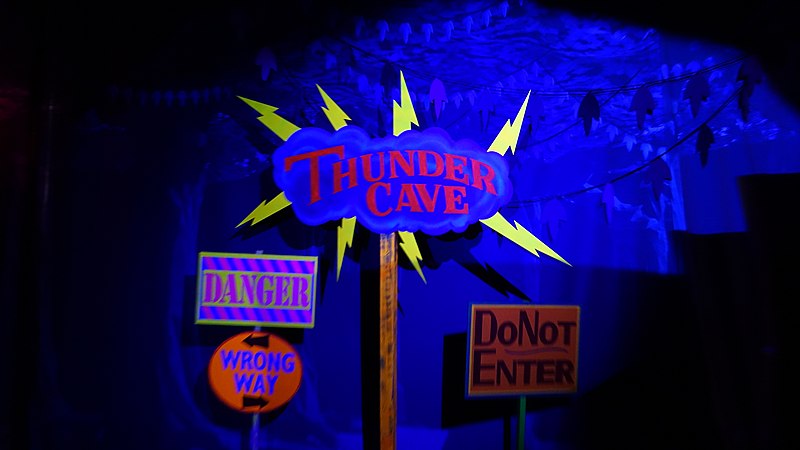
Still the trolleys trek onward, leaving the camp behind and following arrows and marquees toward the Fair. There’s just one problem. Ahead, signs warn: “DANGER!” “DO NOT ENTER!” “WRONG WAY!” “TURN BACK!” and above them all, a sign painted like a storm cloud with lightning bolts tearing out in each direction, reading, “THUNDER CAVE”! It’s too late, of course, as the trolleys carefully advance in.
As thunder rumbles and lighting flashes, the rocky interior of the cave seems to close in. The streetcar leans forward, beginning a long descent through the cave as glowing, goofy, fuzzy spiders rappel from the cave walls. (Crump suggests that this long descent remain from an early iteration when Arrow Development would’ve manufactured the ride. In that version, this descent through the Thunder Cave would actually have been gravity-powered… a family-friendly roller coaster hill in the dark, with the lightning flashes meant to disorient guests and weaken their night vision for the scene to come…)

Now in the deepest, darkest part of the path to the Fair, we’ve slid into the Weird Woods. “Population: SCARY.” In fact, the Weird Woods is a forest of DayGlo creatures that are equal parts bizarre and hilarious. Duck-footed bats; chicken-snails; mosquito-birds; llama-donkeys; buzzard dragonflies. These colorful hybrids are characters in their own right, nodding, flapping, and flying past guests as the plucking score of “Welcome One and All” returns.
“What comes next is indescribable! But believe me, I’m not bribable,
I wouldn’t put it in words for a million pies!
It’s the wildest, weirded place anyone in the human race
Ever beheld before bewildered eyes!”
Dipping down into a bog, a magnificent sight appears ahead: a glittering marquee dotted with flashing lightbulbs. It reads: “ANNUAL COUNTY FAIR”! We’ve made it! After a spectacular journey, the ride’s finale brings us to the County Fair where wonders await. Snake oil salesman “Doctor Fox” stands at his wagon, offering cures for what ails us – “Corns,” “Hang nails,” even “Nose hairs”!

Madam Wong – the panda bear fortune teller – bangs a gong as riders pass her tent. Theda Bear has made it from the Gypsy Camp, offering her metaphysical services. Nearby, Harry Rabbit and his son Jack perform puppet shows of a magical juggling act! Characters wave from the trees overhead, or float in suspended hot air balloons.
In a rousing, jazzy musical finale, guests pass by musicians, acrobats, and more all as blacklight gives way once more to incandescent lightbulbs. And there, of course, with the Blue Ribbon, is the Bear-y family, being photographed to remember their day at the Fair.
As Crafty Coyote tries to reach from his “Pie Thief” paddy wagon to reach a boysenberry pie, Boysen, Girlsen, Flapper, and Elder Bear-y wave goodbye to guests. “Goodbye!” Ta-ta!”
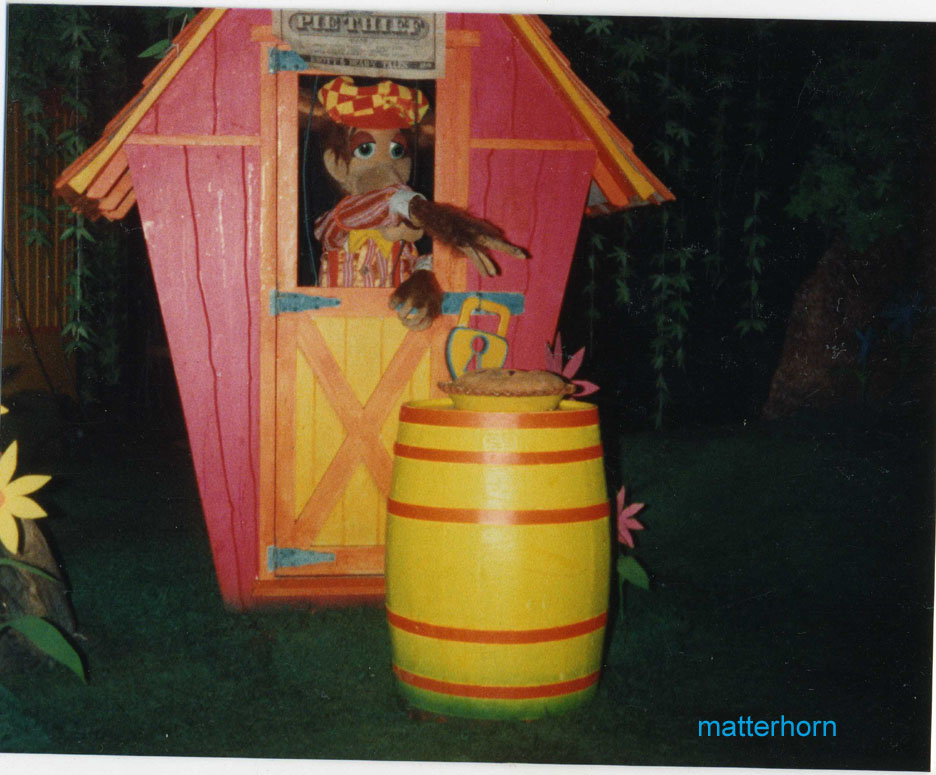
Now take the word “Fair” and make it elastic; stretch it out till it reads “Fantastic”
Utt-er-ly fantastic, that’s no lie!
When your laughter finally ends, all your ole Knott’s Bear-y friends
Will say “Goodbear-y!” Oops! I mean, “Goodbye!”
Welcome one and all! Ya’ll come have a ball!
Things are very fine, riding on the ole Knott’s Bear-y line!”
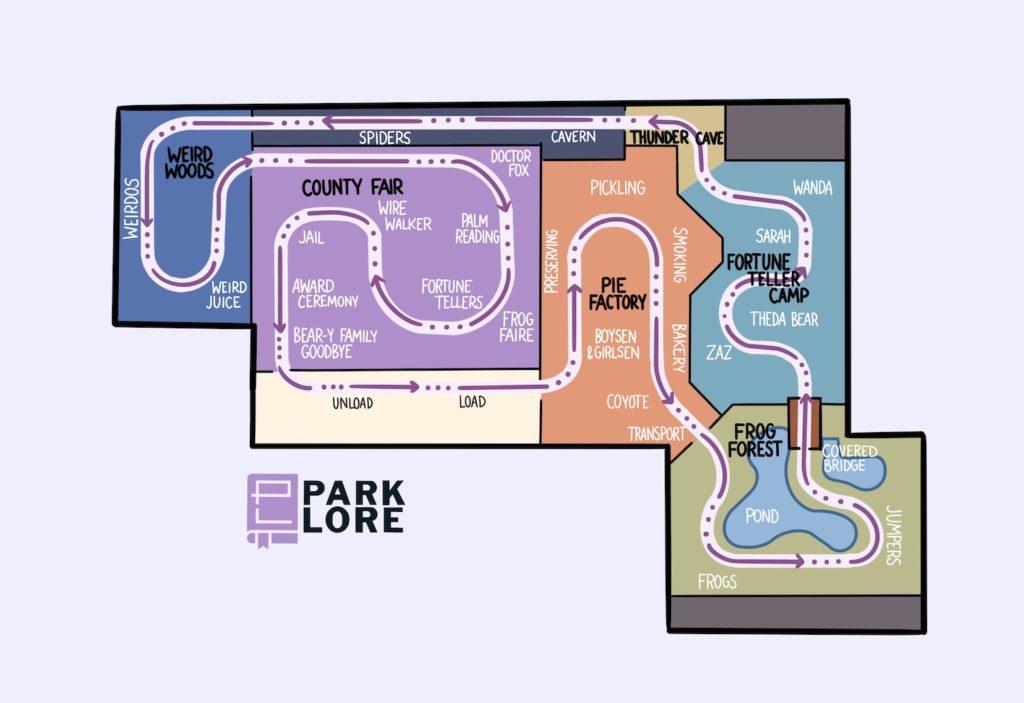
As you know, we always like to end our Lost Legend entries with a ride-through video showing the attraction in action. Knott’s Bear-y Tales closed in 1986 – well before home photography could easily capture a dark ride. Videos of the experience that remain are from its final weeks or days of operation, when the attraction, its audio, and its animatronics had largely seen better days… but a video can still give a good sense of the ride’s spirit and characters! Feel free to watch a clearer, “lights-on” video of the ride at the end of its lifetime here, or the proper show-lighting via home video below:
End of the Ride
By the mid-1980s – after the deaths of her parents Cordelia (1974) and Walter (1981) – Marion Knott chose to step back from the daily operations of the park. A new general manager, Terry Van Gorder, believed that there were better uses for the Bear-y Tales space.
After the summer of 1986, Knott’s Bear-y Tales closed forever after barely a decade – a relatively short life for a ride remembered so fondly! (In an extremely strange twist, the ride was used that fall for Knott’s annual Halloween Haunt event. With most of its figures removed and those that remains turned off, the bare scenes were populated by Halloween props and hidden “Scareactors” who jumped out at guests as they slowly rolled by in 1920s trolleys. You can watch a lights-on video of the experience here.)

It’s easy to see why Knott’s Bear-y Tales was remembered for decades, still talked about in the kind of glowing terms often reserved only for Disney’s Lost Legends. It’s probably not a coincidence. Even though most riders wouldn’t have had a clue who Rolly Crump was, Bear-y Tales was so decisively his; a ride born from the mind of a gifted Disney Imagineer and wrapped in his beautifully vibrant stylization. So what happened next? Read on…



